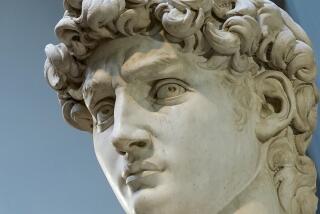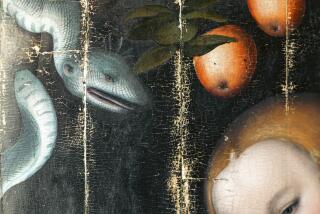At Vatican, Nude Art Is Too Much to Bare : Sistine Chapel: Some private parts will stay private after restoration.
- Share via
VATICAN CITY — Here is the final word on “The Last Judgment”: Art and history demand a partial cover-up.
So said experts this week, announcing the final phase of the restoration of Michelangelo’s Renaissance masterpiece painting behind the altar in the Sistine Chapel.
It has taken four years to restore the 60-foot-tall fresco of a righteous God rewarding the faithful and hurling sinners to the fires of hell. When “The Last Judgment” returns to public view around Easter, it will mark the first time in 14 years that the chapel where Popes are elected can be seen in its restored entirety.
Before that happens, though, there are some hard decisions to make regarding 38 “modesty breeches” added over the centuries at the instruction of Popes who believed that Michelangelo had painted altogether too much of some of his saints and sinners.
Some of the breeches, pronounced “britches,” were ordered by the Council of Trent in the Counter-Reformation in the 16th Century.
Others were added in the 17th and 18th centuries at the whim of later pontiffs, said chief restorer Gianluigi Colalucci. “They are all in tempera, with the original underneath, and we are in the process of deciding which ones to keep,” Colalucci said.
“We will leave the ones done by Daniele da Volterra in the 16th Century and take away the later additions.”
A tour of the scaffolding with Vatican Museum officials one cold morning this week offered a firsthand view of the censor’s art.
Michelangelo himself dressed Christ and his mother, her eyes averted from the anguish and exaltation of the moment of judgment. He also draped strategic bits of cloth here and there and coiled a cobra around the private parts of a hell-bound fat man with donkey’s ears.
Two saints--one he, one she--whom Michelangelo painted in the altogether, were dressed by his successors, who also resorted to artifices ranging from fig leaves to girdles to something like jock straps to what look like belly bags gone south.
As in the decade-long restoration that brought bright color back to the world’s most famous ceiling, work on Judgment Wall has removed four centuries of grime and soot, most of it from the smoke of candles and oil lamps.
As restored, “The Last Judgment” is more dramatic and warmer than the ceiling.
Painted by an aging Michelangelo from 1536 to 1541, it now bursts with color, dominated by a rich blue made conspicuous by its scarcity on the ceiling begun three decades before.
“The blue comes from lapis lazuli, a ground stone that had to be imported and was terribly expensive. For the ceiling, Michelangelo was paid a flat fee, including materials and paint. For ‘The Last Judgment,’ though, he had a handsome salary, and the Pope paid separately for the paint--so he used the best,” said Fabrizio Mancinelli, a Vatican Museum director.
Comparing the two restorations, Mancinelli said, it is clear that as painting, “The Last Judgment” is superior. In it, Michelangelo demonstrates some influence of Venetian painting and shows that he has traveled far from his Florentine roots that dominate on the ceiling, he said.
Mancinelli says that art, history and common sense all will be weighed in coming months in determining which of the cover-up breeches to remove.
“We could not easily conserve the later ones. They were painted dark to match the color of the painting as it aged. To save them, they would have to be retouched,” Mancinelli said.
Mancinelli, though, has affection for the early breeches. He believes that Da Volterra, in painting over parts of the masterpiece, may have saved “The Last Judgment” even as he defiled it. The Council of Trent ordered paintings destroyed elsewhere in Rome but made an exception with Michelangelo.
“They put up the scaffold in January, 1564, and left it there for two years to accomplish a very little work. Daniele didn’t paint until ‘65, and when he died in ’66 it was still there.”
Mancinelli suspects that the scaffold was used to screen the painting from mind and eye until impulses that might have destroyed it had dispelled.
“We must be respectful of these breeches,” he said.
More to Read
The biggest entertainment stories
Get our big stories about Hollywood, film, television, music, arts, culture and more right in your inbox as soon as they publish.
You may occasionally receive promotional content from the Los Angeles Times.










